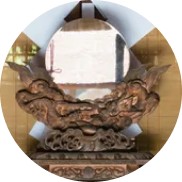Shinkyo
Shinkyo or “god’s mirror” is a mystical object that is said to connect our world to the spiritual realm. Shinkyo can be seen displayed on Shinto altars as an avatar of the kami, the idea being that the god will enter the mirror to interact with our world. This belief dates back to a legend involving the Japanese sun goddess, Amaterasu, who once hid in a cave, plunging the world into darkness. In order to persuade her to leave the cave, several other gods gathered outside the cave and threw a party. The gods hung jewels and a mirror from a sakaki tree in front of the cave to distract Amaterasu’s attention if she ventured outside. Curious about the festive noises, Amaterasu peeked out of the cave and asked why the other gods were celebrating. In response, she was told that there was a goddess even more beautiful than her outside the cave. On leaving the cave, she was greeted by the mirror and her own reflection, at which point the other gods took the opportunity to seal the cave with a shimenawa.
This same mirror was later given to Amaterasu’s grandson with instructions to worship it as if it were Amaterasu herself. In this way, you don’t necessarily pray to a shinkyo, but to the god of that shrine for which the mirror is acting as a physical avatar. The shinkyo is considered a “shintai”, or a physical substitute that the kami can inhabit in the human realm.
By the way, the cave described in the legend is actually a real place, now called Amanoyasugawara Shrine, in Miyazaki Prefecture.


